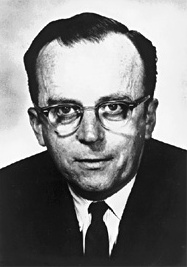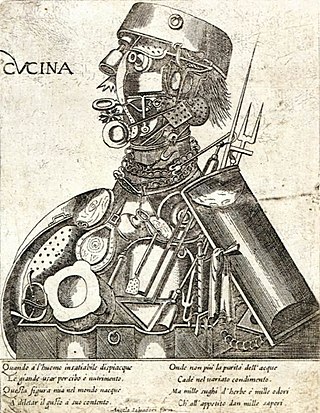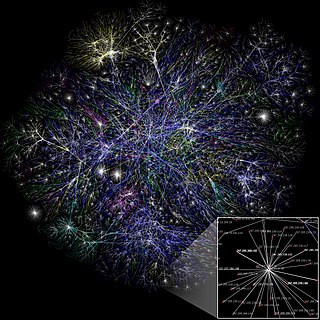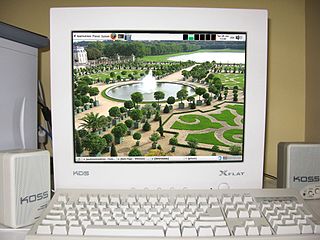Related Research Articles
Distributed computing is a field of computer science that studies distributed systems, defined as computer systems whose inter-communicating components are located on different networked computers.
Information retrieval (IR) in computing and information science is the task of identifying and retrieving information system resources that are relevant to an information need. The information need can be specified in the form of a search query. In the case of document retrieval, queries can be based on full-text or other content-based indexing. Information retrieval is the science of searching for information in a document, searching for documents themselves, and also searching for the metadata that describes data, and for databases of texts, images or sounds.

Memex [memory expansion] is a hypothetical electromechanical device for interacting with microform documents and described in Vannevar Bush's 1945 article "As We May Think". Bush envisioned the memex as a device in which individuals would compress and store all of their books, records, and communications, "mechanized so that it may be consulted with exceeding speed and flexibility". The individual was supposed to use the memex as an automatic personal filing system, making the memex "an enlarged intimate supplement to his memory".
Collaborative software or groupware is application software designed to help people working on a common task to attain their goals. One of the earliest definitions of groupware is "intentional group processes plus software to support them."
The Information Processing Techniques Office (IPTO), originally "Command and Control Research", was part of the Defense Advanced Research Projects Agency of the United States Department of Defense.

The Advanced Research Projects Agency Network (ARPANET) was the first wide-area packet-switched network with distributed control and one of the first computer networks to implement the TCP/IP protocol suite. Both technologies became the technical foundation of the Internet. The ARPANET was established by the Advanced Research Projects Agency of the United States Department of Defense.

Joseph Carl Robnett Licklider, known simply as J. C. R. or "Lick", was an American psychologist and computer scientist who is considered to be among the most prominent figures in computer science development and general computing history.

Robert William Taylor, known as Bob Taylor, was an American Internet pioneer, who led teams that made major contributions to the personal computer, and other related technologies. He was director of ARPA's Information Processing Techniques Office from 1965 through 1969, founder and later manager of Xerox PARC's Computer Science Laboratory from 1970 through 1983, and founder and manager of Digital Equipment Corporation's Systems Research Center until 1996.

SRI International's Augmentation Research Center (ARC) was founded in the 1960s by electrical engineer Douglas Engelbart to develop and experiment with new tools and techniques for collaboration and information processing.
In computer science, interactive computing refers to software which accepts input from the user as it runs.
Computer-supported collaboration research focuses on technology that affects groups, organizations, communities and societies, e.g., voice mail and text chat. It grew from cooperative work study of supporting people's work activities and working relationships. As net technology increasingly supported a wide range of recreational and social activities, consumer markets expanded the user base, enabling more and more people to connect online to create what researchers have called a computer supported cooperative work, which includes "all contexts in which technology is used to mediate human activities such as communication, coordination, cooperation, competition, entertainment, games, art, and music".

Intelligence amplification (IA) is the use of information technology in augmenting human intelligence. The idea was first proposed in the 1950s and 1960s by cybernetics and early computer pioneers.
EcoBot or “”Eco-Bot”” is short for Ecological Robot and it refers to a class of energetically autonomous robots that can remain self-sustainable by collecting their energy from material, mostly waste matter, in the environment. The only by-product from this process is carbon dioxide, which would have been produced from the natural biodegradation of the fuel regardless. This carbon dioxide production belongs to the immediate carbon cycle of our planet and does not impose to the already increasing problem of the greenhouse effect.
Dr. Lawrence Jerome Fogel was a pioneer in evolutionary computation and human factors analysis. He is known as the inventor of active noise cancellation and the father of evolutionary programming. His scientific career spanned nearly six decades and included electrical engineering, aerospace engineering, communication theory, human factors research, information processing, cybernetics, biotechnology, artificial intelligence, and computer science.

The global brain is a neuroscience-inspired and futurological vision of the planetary information and communications technology network that interconnects all humans and their technological artifacts. As this network stores ever more information, takes over ever more functions of coordination and communication from traditional organizations, and becomes increasingly intelligent, it increasingly plays the role of a brain for the planet Earth. In the philosophy of mind, global brain finds an analog in Averroes's theory of the unity of the intellect.

"As We May Think" is a 1945 essay by Vannevar Bush which has been described as visionary and influential, anticipating many aspects of information society. It was first published in The Atlantic in July 1945 and republished in an abridged version in September 1945—before and after the atomic bombings of Hiroshima and Nagasaki. Bush expresses his concern for the direction of scientific efforts toward destruction, rather than understanding, and explicates a desire for a sort of collective memory machine with his concept of the memex that would make knowledge more accessible, believing that it would help fix these problems. Through this machine, Bush hoped to transform an information explosion into a knowledge explosion.
Computational thinking (CT) refers to the thought processes involved in formulating problems so their solutions can be represented as computational steps and algorithms. In education, CT is a set of problem-solving methods that involve expressing problems and their solutions in ways that a computer could also execute. It involves automation of processes, but also using computing to explore, analyze, and understand processes.

Cybernetics is the transdisciplinary study of circular processes such as feedback systems where outputs are also inputs. It is concerned with general principles that are relevant across multiple contexts, including in ecological, technological, biological, cognitive and social systems and also in practical activities such as designing, learning, and managing.

Human–computer interaction (HCI) is research in the design and the use of computer technology, which focuses on the interfaces between people (users) and computers. HCI researchers observe the ways humans interact with computers and design technologies that allow humans to interact with computers in novel ways. A device that allows interaction between human being and a computer is known as a "Human-computer Interface (HCI)".
Informatics is the study of computational systems. According to the ACM Europe Council and Informatics Europe, informatics is synonymous with computer science and computing as a profession, in which the central notion is transformation of information. In some cases, the term "informatics" may also be used with different meanings, e.g. in the context of social computing, or in context of library science.
References
- ↑ T. Messbarger - Short-Biography of J.C.R. Licklider published by Ohio University [Retrieved 2015-08-08]
- 1 2 3 Licklider, J. C. R. (March 1960). "Man-Computer Symbiosis". IRE Transactions on Human Factors in Electronics. HFE-1: 4–11. doi:10.1109/THFE2.1960.4503259. ISSN 2168-2836.
- 1 2 Jacucci, Giulio; Spagnolli, Anna; Freeman, Jonathan; Gamberini, Luciano (2014). "Symbiotic Interaction: A Critical Definition and Comparison to other Human-Computer Paradigms". In Jacucci, Giulio; Gamberini, Luciano; Freeman, Jonathan; Spagnolli, Anna (eds.). Symbiotic Interaction: Third International Workshop, Symbiotic 2014, Helsinki, Finland, October 30-31, 2014, Proceedings. Lecture Notes in Computer Science. Vol. 8820. Cham: Springer-Verlag. pp. 3–20. doi:10.1007/978-3-319-13500-7_1. ISBN 9783319135007. OCLC 900120411.
- 1 2 3 4 Streeter, Thomas (2011). The Net Effect: Romanticism, Capitalism, and the Internet . Critical Cultural Communication. Vol. 32. New York: NYU Press. p. 32–34. doi:10.18574/nyu/9780814741153.001.0001. ISBN 9780814741160. JSTOR j.ctt9qfwf9. OCLC 630468250.
- ↑ Bardini, Thierry (2000). Bootstrapping: Douglas Engelbart, Coevolution, and the Origins of Personal Computing . Writing Science. Stanford, Calif.: Stanford University Press. pp. 20–21. ISBN 0804738718. OCLC 44467462.
- ↑ Fuchs-Kittowski, Klaus (2014). "The Influence of Philosophy on the Understanding of Computing and Information". In Hagengruber, Ruth; Riss, Uwe V. (eds.). Philosophy, Computing and Information Science. History and Philosophy of Technoscience. Vol. 3. London: Pickering & Chatto. pp. 45–56 (50). ISBN 9781848935082. OCLC 876292357.
- ↑ Fuchs-Kittowski, Klaus (2006). "Strategies for the Effective Integration of ICT into Social Organization—Organization of Information Processing and the Necessity of Social Informatics". In Berleur, Jacques; Nurminen, Markku I.; Impagliazzo, John (eds.). Social Informatics: An Information Society for All? In Remembrance of Rob Kling: Proceedings of the Seventh International Conference 'Human Choice and Computers' (HCC7), IFIP TC 9, Maribor, Slovenia, September 21-23, 2006. IFIP Advances in Information and Communication Technology. Vol. 223. Boston, MA: Springer-Verlag. pp. 431–444 (436). doi:10.1007/978-0-387-37876-3_34. ISBN 9780387378756. OCLC 74270532.
- ↑ Foster, Ian (2008). "Human-Machine Symbiosis, 50 Years On" . In Grandinetti, Lucio (ed.). High Performance Computing and Grids in Action. Advances in Parallel Computing. Vol. 16. Amsterdam; Washington, DC: IOS Press. pp. 3–15. arXiv: 0712.2255 . ISBN 9781586038397. OCLC 221165979.
- ↑ Russell, Andrew L. (2014). Open Standards and the Digital Age: History, Ideology, and Networks. Cambridge Studies in the Emergence of Global Enterprise. New York: Cambridge University Press. p. 164. doi:10.1017/CBO9781139856553. ISBN 9781107039193.
- ↑ Blastophaga Merriam-Webster [Retrieved 2015-08-08]
- ↑ En-Wei Tian, Hui Yu, Da-Yong Zhang and John D. Nason - Development of microsatellite loci for Blastophaga javana (Agaonidae), the pollinating wasp of Ficus hirta (Moraceae) [ dead link ] published by American Journal of Botany (Am. J. Bot. February 2011 vol. 98 no. 2 e41-e43), ajb.1000432v198/2/e41 (AJB Primer Notes & Protocols in the Plant Sciences) [Retrieved 2015-08-08]
- ↑ J. D. North, "The rational behavior of mechanically extended man", Boulton Paul Aircraft Ltd., Wolverhampton, Eng.; September, 1954.
- ↑ Fredkin, Edward (September 1960). "Trie memory". Communications of the ACM . 3 (9): 490–499. doi: 10.1145/367390.367400 .
- ↑ Shaw, J. Cliff; Newell, Allen; Simon, Herbert A.; Ellis, T. O. (May 1958). "A command structure for complex information processing". IRE-ACM-AIEE '58 (Western): Proceedings of the May 6–8, 1958, Western Joint Computer Conference: Contrasts In Computers. New York: Association for Computing Machinery. pp. 119–128. doi: 10.1145/1457769.1457803 . ISBN 978-1-4503-7864-2.
- ↑ T.K. Tomasello (15 March 2004). "Electronic Theses, Treatises and Dissertations. Paper 1285". A Content Analysis of Citations to J. C. R. Licklider's "Man-Computer Symbiosis," 1960-2001: Diffusing the Intergalactic Network (Thesis). Florida State University. Retrieved 13 August 2015.
- ↑ Human Factors in Electronics, IRE Transactions on [Retrieved 2015-08-08]
- ↑ J. C. R. Licklider and Welden Clark (August 1962). "On-Line Man-Computer Communication" (PDF). AIEE-IRE '62 (Spring): 113–128.
- ↑ PILOT: A STEP TOWARDS MAN-COMPUTER SYMBIOSIS Massachusetts Institute of Technology Cambridge, MA, USA 1966 [Retrieved 2015-08-13]
- ↑ N LESH; J MARKS; C RICH; CL SIDNER (June 2004). ""Man-Computer Symbiosis" Revisited: Achieving Natural Communication and Collaboration with Computers". IEICE Transactions on Information and Systems. E87-D (6): 1290–1298. Retrieved 8 August 2015.